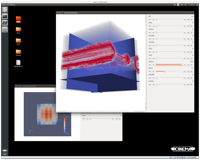Extreme scale scientific simulations are pushing the limits of scientific computation, and are stressing the limits of the data that we can store, explore, and understand. Options for extreme scale data analysis are often presented as a stark contrast: save massive data files to disk for interactive, exploratory visualization, or perform in situ analysis to save detailed data about phenomena a scientist knows about in advance. We propose that there is an alternative approach – a highly interactive, image-based approach that promotes exploration of simulation results, and is easily accessed through extensions to widely used open source tools. This new approach supports interactve exploration of a wide range of results, while still significantly reducing data movement and storage. We call this new approach Cinema. The tutorial linked to here assumes that you are somewhat familiar with the technical motivations that drove the creation of Cinema, but further technical detail can be found in the SC14 paper also linked to below. We have created the Cinema Virtual Machine (CVM) to provide a hands-on way of understanding some of the concepts behind Cinema, along with the deeper technical ideas. With the CVM, you can explore several small Cinema databases, explore concrete examples of the Cinema file specification, and get hands-on experience creating in situ export scripts with an MPAS-coupled analysis workflow.
